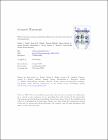| dc.contributor.author | HAMPEL, HARALD | en |
| dc.contributor.author | BOKDE, ARUN LAWRENCE WARREN | en |
| dc.date.accessioned | 2009-11-02T17:10:28Z | |
| dc.date.available | 2009-11-02T17:10:28Z | |
| dc.date.issued | 2010 | en |
| dc.date.submitted | 2010 | en |
| dc.identifier.citation | Stefan J. Teipel, Arun L.W. Bokde, Thomas Meindl, Edson Amaro Jr., Jasmin Soldner, Maximilian F. Reiser, Sabine C. Herpertz, Hans-Jurgen Moller and Harald Hampel, White matter microstructure underlying default mode network connectivity in the human brain, NeuroImage, 49, 3, 2010, 2021 - 2032 | en |
| dc.identifier.other | Y | en |
| dc.identifier.uri | http://hdl.handle.net/2262/34466 | |
| dc.description | PUBLISHED | en |
| dc.description | PubMed ID: 19878723 | en |
| dc.description.abstract | Resting state functional magnetic resonance imaging (fMRI) reveals a distinct network of correlated brain function representing a default mode state of the human brain. The underlying structural basis of this functional connectivity pattern is still widely unexplored. We combined fractional anisotropy measures of fiber tract integrity derived from diffusion tensor imaging (DTI) and resting state fMRI data obtained at 3 Tesla from 20 healthy elderly subjects (56 to 83 years of age) to determine white matter microstructure underlying default mode connectivity. We hypothesized that the functional connectivity between the posterior cingulate and hippocampus from resting state fMRI data would be associated with the white matter microstructure in the cingulate bundle and fiber tracts connecting posterior cingulate gyrus with lateral temporal lobes, medial temporal lobes and precuneus. This was demonstrated at the p < 0.001 level using a voxel-based multivariate analysis of covariance (MANCOVA) approach. In addition, we used a data driven technique of joint independent component analysis (ICA) that uncovers spatial pattern that are linked across modalities. It revealed a pattern of white matter tracts including cingulate bundle and associated fiber tracts resembling the findings from the hypothesis-driven analysis and was linked to the pattern of default mode network (DMN) connectivity in the resting state fMRI data. Our findings support the notion that the functional connectivity between the posterior cingulate and hippocampus and the functional connectivity across the entire DMN is based on distinct pattern of anatomical connectivity within the cerebral white matter. | en |
| dc.description.sponsorship | Part of this work was supported by grants of the Medical Faculty of the Ludwig-
Maximilian University (Munich, Germany) to S.J.T., of the Hirnliga e. V. (Nurmbrecht,
Germany) to S.J.T., an investigator initiated unrestricted research grant from Janssen-CILAG
(Neuss, Germany) to H.H. and S.J.T., and a grant from the Bundesministerium fur Bildung
und Forschung (BMBF 01 GI 0102) awarded to the dementia network ?Kompetenznetz
Demenzen?. Further funding was obtained through the Science Foundation Ireland (SFI)
Stokes Programme (to A.L.W.B.), and through the SFI investigator neuroimaging programme
grant 08/IN.1/B1846 (H.H.). | en |
| dc.format.extent | 2021 | en |
| dc.format.extent | 2032 | en |
| dc.format.mimetype | application/pdf | |
| dc.language.iso | en | en |
| dc.relation.ispartofseries | NeuroImage | en |
| dc.relation.ispartofseries | 49 | en |
| dc.relation.ispartofseries | 3 | en |
| dc.rights | Y | en |
| dc.subject | Default mode; resting state fMRI; DTI; functional connectivity; structural connectivity; brain function | en |
| dc.title | White matter microstructure underlying default mode network connectivity in the human brain | en |
| dc.type | Journal Article | en |
| dc.type.supercollection | scholarly_publications | en |
| dc.type.supercollection | refereed_publications | en |
| dc.identifier.peoplefinderurl | http://people.tcd.ie/hampel | en |
| dc.identifier.peoplefinderurl | http://people.tcd.ie/bokdea | en |
| dc.identifier.rssinternalid | 62022 | en |
| dc.identifier.rssuri | http://dx.doi.org/10.1016/j.neuroimage.2009.10.067 | |




